Class 4 Exam > Class 4 Notes > Mathematics Class 4 ICSE > Chapter notes: Subtraction
Chapter notes: Subtraction | Mathematics Class 4 ICSE PDF Download
Introduction
Subtraction is like taking away candies from a jar, making it easier to understand how many are left! In this exciting chapter for Class 4, we dive into the world of subtracting numbers, exploring how to handle up to four-digit numbers, with or without borrowing. We'll learn cool tricks like using expanded form, estimating differences, and even solving real-life word problems. Get ready to become a subtraction superstar as we uncover step-by-step methods to make numbers shrink in a fun and simple way!

Subtraction of Numbers (without borrowing)
- Subtract numbers starting from the ones place, then move to tens, hundreds, and thousands.
- Align numbers properly in columns to avoid mistakes.
- Subtract each digit in the corresponding place value and write the result below.
Example: Subtract 3,263 from 4,978
- Step 1: Subtract ones: 8 - 3 = 5
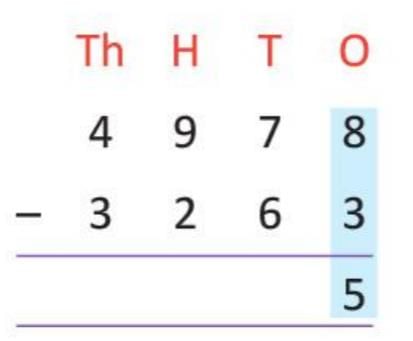
- Step 2: Subtract tens: 7 - 6 = 1
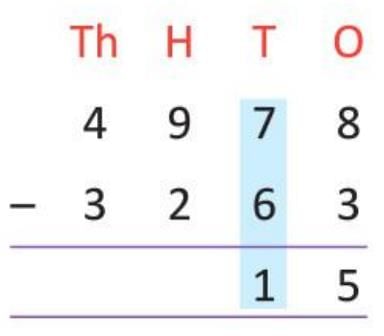
- Step 3: Subtract hundreds: 9 - 2 = 7
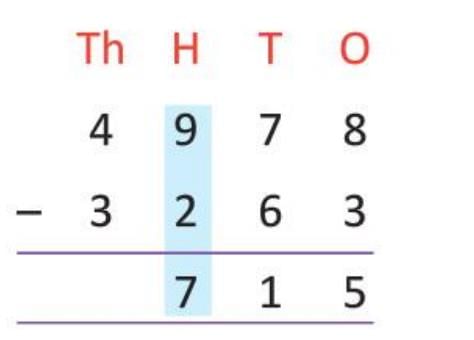
- Step 4: Subtract thousands: 4 - 3 = 1
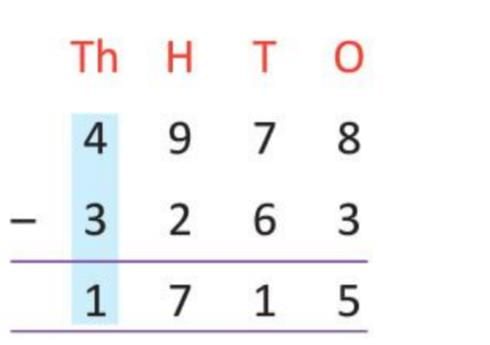
- Result: 4,978 - 3,263 = 1,715
Subtraction of Numbers (with borrowing)
- If a digit in the minuend is smaller than the digit in the subtrahend, borrow from the next higher place value.
- Borrowing 1 from a higher place reduces that place by 1 and adds 10 to the lower place.
- Continue subtracting place by place after borrowing.
Example: Subtract 3,252 from 7,439
- Step 1: Subtract ones: 9 - 2 = 7
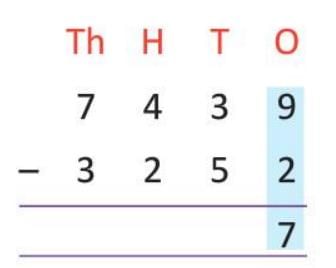
- Step 2: Tens: 3 tens is less than 5 tens, so borrow 1 hundred (10 tens) from 4 hundreds, making it 3 hundreds. Now, 3 tens + 10 tens = 13 tens. Subtract: 13 - 5 = 8 tens.
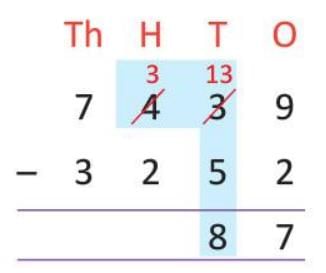
- Step 3: Subtract hundreds: 3 - 2 = 1
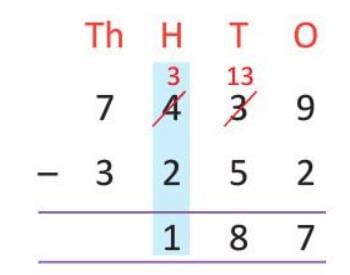
- Step 4: Subtract thousands: 7 - 3 = 4
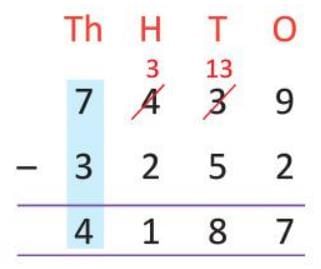
- Result: 7,439 - 3,252 = 4,187
Subtraction Facts
- Subtracting 0 from a number gives the same number.
- Subtracting 1 from a number gives its predecessor.
- Subtracting a number from itself results in 0.
- Subtraction is not commutative; the order of numbers matters.
Example:
- 1,436 - 0 = 1,436
- 8,234 - 1 = 8,233
- 5,324 - 5,324 = 0
- 2,365 - 1,423 = 942, but 1,423 - 2,365 is not possible as 1,423 is less than 2,365.
Subtraction Using Expanded Form
- Write both numbers in expanded form (thousands, hundreds, tens, ones).
- Subtract the values for each place value separately.
- Add the differences from each place to get the final result.
Example: Subtract 6,254 from 8,795 using expanded form
- Step 1: Expand numbers: 8,795 = 8,000 + 700 + 90 + 5, 6,254 = 6,000 + 200 + 50 + 4

- Step 2: Subtract each place:

- Step 3: Add differences: 2,000 + 500 + 40 + 1 = 2,541
- Result: 8,795 - 6,254 = 2,541
Checking Subtraction
- Add the difference to the subtrahend.
- If the sum equals the minuend, the subtraction is correct.
- If the sum does not match, there is an error in the subtraction.
Example: Subtract 7,254 from 8,106 and check
- Step 1: Subtract:
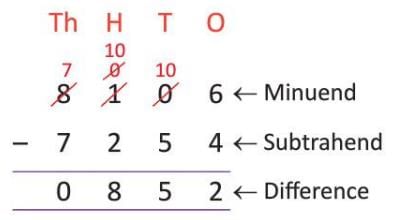
- Result: 8,106 - 7,254 = 852
- Step 2: Check: 852 (difference) + 7,254 (subtrahend) = 8,106 (minuend)
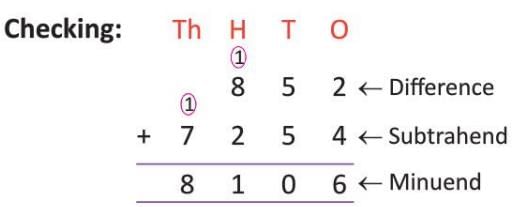
- Conclusion: Subtraction is correct.
Finding the Missing Digits
- Use the relationship: minuend - subtrahend = difference.
- To find a missing subtrahend digit, subtract the difference from the minuend in that place.
- To find a missing minuend digit, add the subtrahend and difference in that place.
Example: Find missing digits in ?6?2 - 5?41 = 234?
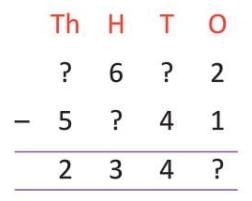
- Step 1: Look at the ones column.2 − 1 = ?, 2 − 1 = 1. So, write 1 in the blank space.
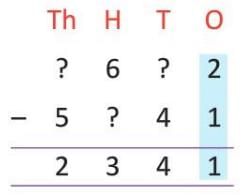
- Step 2:
? − 4 = 4
To find the missing minuend in the tens column, add the subtrahend to the difference.
4 + 4 = 8 (subtrahend + difference = minuend)
So, write 8 in the blank space.
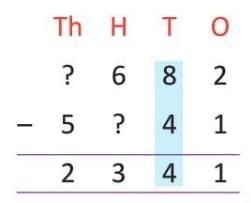
- Step 3:
6 − ? = 3
In the hundreds column, to find the missing subtrahend, subtract the difference from the minuend.
6 − 3 = 3 (minuend − difference = subtrahend)
So, write 3 in the blank space.
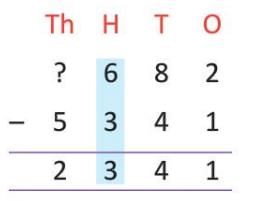
- Step 4:
? − 5 = 2
In the thousands column, to find the missing minuend, add the subtrahend to the difference.
5 + 2 = 7 (subtrahend + difference = minuend)
So, write 7 in the blank space.
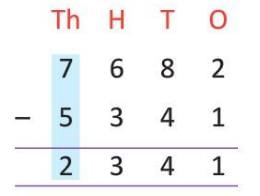
Estimating the Difference
- Round the minuend and subtrahend to the nearest 10, 100, 1,000, etc., as specified.
- Subtract the rounded numbers to find the estimated difference.
- Compare with the actual difference to verify the estimate.
Example: Find the difference between 6,875 and 3,256 using estimation by rounding to the nearest 100. Verify by finding the actual value.
- Step 1:Round numbers:
- 6,875 rounds to 6,900
- 3,256 rounds to 3,300
- Step 2: Estimate: 6,900 - 3,300 = 3,600
- Step 3:Actual subtraction:
- Ones: 5 - 6 (borrow 1 ten, 15 - 6 = 9)
- Tens: 6 - 5 = 1
- Hundreds: 8 - 2 = 6
- Thousands: 6 - 3 = 3
- Actual result: 6,875 - 3,256 = 3,619
- Step 4: Compare: Actual difference 3,619, when rounded to the nearest 100, is 3,600 (estimated difference).

Solving Word Problems
- Identify the minuend (larger number) and subtrahend (smaller number) from the problem.
- Align numbers and subtract, using borrowing if needed.
- Write the answer in the context of the problem.
Example: A train carried 3,499 passengers on the first day and 4,659 on the second day. How many more passengers on the second day?
- Step 1: Minuend = 4,659, Subtrahend = 3,499
- Step 2:Subtract:
- Ones: 9 - 9 = 0
- Tens: 5 - 9 (borrow 1 hundred, 15 - 9 = 6)
- Hundreds: 5 - 4 = 1
- Thousands: 4 - 3 = 1
- Result: 4,659 - 3,499 = 1,160. The train carried 1,160 more passengers on the second day.
Framing Word Problems
- Create a real-life scenario where the given subtraction represents the difference.
- Include the minuend as the starting quantity and the subtrahend as the amount taken away.
- Ensure the problem asks for the remaining quantity or difference.
Example: Frame two word problems for 8,750 - 2,375
- Problem 1: A factory made 8,750 pairs of jeans. If 2,375 pairs were sold, how many pairs are left?
- Problem 2: Mr. Jha had ₹8,750. He spent ₹2,375. How much money does he have left?
Addition and Subtraction Together
- Add all numbers without a minus sign first.
- Add all numbers with a minus sign separately.
- Subtract the sum of the numbers with minus signs from the sum of the numbers without minus signs.
Example: Solve 1,129 + 5,372 - 4,013 - 215
- Step 1: Add numbers without minus: 1,129 + 5,372 = 6,501
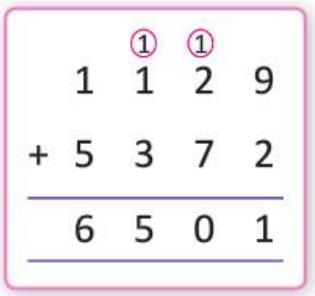
- Step 2: Add numbers with minus: 4,013 + 215 = 4,228
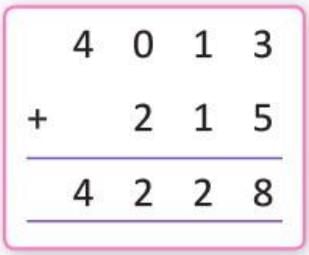
- Step 3: Subtract: 6,501 - 4,228 = 2,273
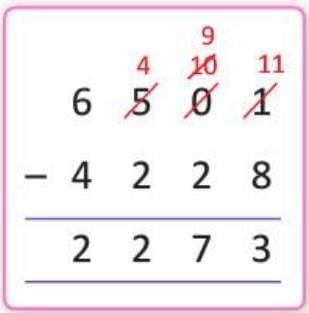
- Result: 1,129 + 5,372 - 4,013 - 215 = 2,273.
The document Chapter notes: Subtraction | Mathematics Class 4 ICSE is a part of the Class 4 Course Mathematics Class 4 ICSE.
All you need of Class 4 at this link: Class 4
|
82 docs|14 tests
|
FAQs on Chapter notes: Subtraction - Mathematics Class 4 ICSE
| 1. What is subtraction without borrowing? |  |
Ans.Subtraction without borrowing refers to the process of subtracting numbers where each digit in the minuend (the top number) is greater than or equal to the corresponding digit in the subtrahend (the bottom number). For example, in the subtraction 54 - 32, each digit can be subtracted without needing to borrow from the next higher place value.
| 2. How do you perform subtraction with borrowing? |  |
Ans.Subtraction with borrowing is used when a digit in the minuend is smaller than the corresponding digit in the subtrahend. To perform this, you need to borrow 1 from the next higher place value. For instance, in 52 - 37, you would borrow 1 from the 5 (making it 4) to turn the 2 into 12, allowing you to subtract 7 from 12.
| 3. What are subtraction facts? |  |
Ans.Subtraction facts are basic subtraction equations that are commonly memorized to help with quick calculations. For example, knowing that 10 - 2 = 8 or 15 - 5 = 10 allows students to solve subtraction problems more efficiently without needing to calculate each time.
| 4. How can I check my subtraction work? |  |
Ans.To check your subtraction work, you can add the difference to the subtrahend and see if it equals the minuend. For example, if you calculated 54 - 32 = 22, you would check by adding 22 + 32. If the sum equals 54, your subtraction is correct.
| 5. What is the importance of estimating the difference in subtraction? |  |
Ans.Estimating the difference helps to quickly assess whether an answer is reasonable. It allows students to round numbers to the nearest ten or hundred and then subtract. For example, estimating 54 - 32 as approximately 50 - 30 = 20 can help confirm that a detailed calculation of 22 is reasonable.
Related Searches
















